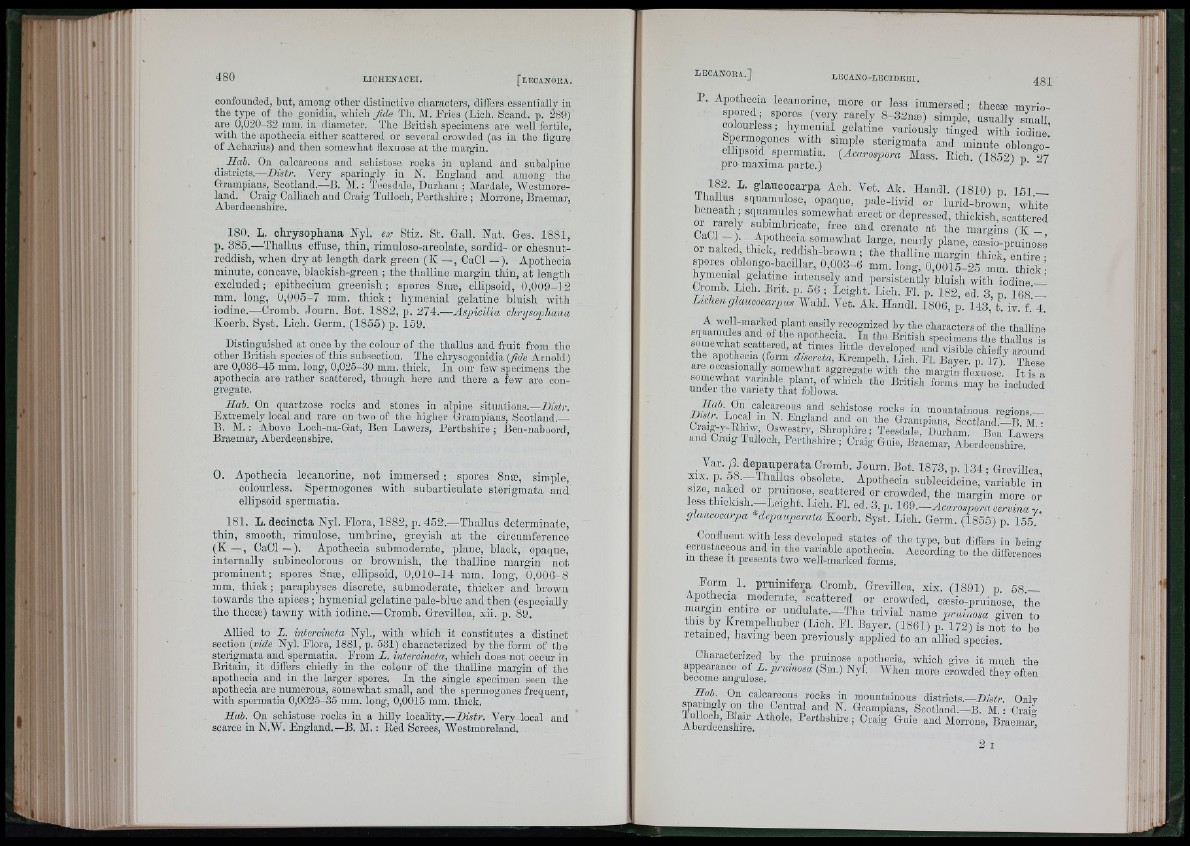
:f j < i.1,
•'111
, 'î
confounded, but, among other distinctive characters, differs essentially in
the t3'pe of the gouidia, whicli Jide Th. AI. Fries (Licli. Scand. p. 289)
are 0,020-32 nmi. iu diameter. The British specimens are well fertile,
with the apothecia eitlier scattered or several crowded (as in tho ligiire
of Acharius) and then somewhat flexuose at the margin.
Hab. On calcareous aud schistose rocks in uplaud and subalpine
districts.—Disii-. Very spariugly in N. Fngland aud among tho
Grampians, S co tlan d .-B . AI.: Teesdale, Durham ; Alardale, Westmoreland.
Craig Calliach and Craig Tulloch, rerthsliire ; Alorrone, Braemar,
Aberdeenshire.
180. L. chrysophana Nyl. ex Stiz. St. Gall. Nat. Ges. 1881,
p. 385.—Thallus effuse, thin, rimuloso-areolate, sordid- or chesimt-
rcddish, when dry a t length dark green (K —, OaCl —). Apothecia
miuute, concave, blackish-grcen ; the thallino margin thin, a t length
excluded; epitheoium g re en ish ; spores Siuc, ellipsoid, 0 ,0 0 9 -1 2
mm. long, 0 ,0 0 5 -7 mm. th io k ; hymemal gelatine bluish with
iodine.— Cromb. Journ. Bot. 1882, p. 2 7 4 .— A spicilia clirysopliana
Koerb. Syst. Lioh. Germ. (1855) p. 159.
Distinguished at once by the colour of the thallus and fruit from the
other British species of this subsection. Tlie chrysogoiiidia (fide Arnold)
are 0,036-45 mm. long, 0,025-30 mm. thick. In our few specimens the
apothecia are rather scattered, though here aud there a few are congregate.
Hah. On quartzose rocks and stones in alpine situations.—Distr.
Extremely local and rare ou two of tiie higher Grampiaus, Scotlaud.—
B. AI. : Above Loch-ua-Gat, Ben Lawers, Pe rth sh ire ; Ben-naboord,
Braemar, Aberdeenshire.
0 . Apothecia lecanorine, n o t immersed ; spores 8næ, simple,
colourless. Spermogones with suba rticu late sterigmata and
ellipsoid spermatia.
181. L. decincta Nyl. Flora, 1882, p. 452.—Thallus determinate,
th in , smooth, rimulose, umbriue, greyish a t tho ciroumferenco
(K —, C aC l—). Apotheoia submoderate, plane, black, opaque,
inte rn ally siibinoolorous or brownish, the thallino margin not
p rom in en t; spores 8næ, ellipsoid, 0 ,0 1 0 -1 4 mm. long, 0 ,0 0 0 -8
mm. th ic k ; paraphyses discrete, submoderate, th ick e r and brown
towards the apices ; hymenial gelatine pale-blue and th en (especially
tho thecæ) tawny w ith iodine.—Cromb. Grevillea, xii. p. 89.
Allied to L. intercincta Nyl., with which it constitutes a distinct
section (vide Nyl. Flora, 1881, p. 631) cliaracterized hy the form of tho
sterigmata and spermatia. From L. intercincta, which does not occur in
Britain,^ it differs chiefly iu the colour of the thalline margin of the
apotheoia and in the larger spores. In the single specimeu seen the
apothecia are numerous, somewhat small, and the spermogones frequent
with spermatia 0,0025-35 min. long, 0,0015 inm. thick. ’
Hub. On schistose rocks in a hilly locality.—Distr. Very local and
scarce in N.W. England.—B. AI. : lied Screes, AVestmoreland.
481
p . Apotheoia leoanorine, more or less immersed; theoæ myrio-
J lo u ile s s ; hymemal gelatine variously tinged with iodine
Sp e rm o p n es with simple sterigmata and minute oblongo-
eihpsoid spermatia. (Acarospora Mass. Rich (1851) u 27
pro maxima parte.) ' ^ J F-
182. L. glaucjarpa Ach. Vet. Ak. Handl. (1810) p. 161 —
Ih a llu s squamufose, opaque, pale-livid or lurid-browu white
beneath : s q u am je s somowhat erect or depressed, thickish, scattered
OT rarely subimhricate, free and crenate a t tho margins ( K -
or nnl7er' n early plane, oæsio-prninosè
or n a k e j thick reddish-brown ; the thaUino margin thick, entire •
spores oWongo+aciIlar, 0,003-(5 mm. long, 0 ,0 0 1 5 -2 5 mm. th ic k ’-
lymcnial g-elatme intensely and persistently bluish with iodine —
toomb. te c h . B n t. p. 56 ; Leight. Lich. Fl. p. 182, ed. 3, p 168‘-
Uchenglaucoearpus Wahl. Vet. Ak. Handl. 1806, p. 143, t iv. L 4.
s a i l i ld e J 'n u to f easily recognized by the characters of the thaUine
squamules and of the apothecia. In the British specimens the thallus is
¿ 1^ 7 * 1 1 “ I f ' ’ developed and visible chiefly around
tlie apothecia (form discreta, Krempelh. Lich. Fl. Bayer, p. 17) These
are occasionally somewhat aggregate with the margin flexuose I t is a
may h e 'h i d e d
Ciaig-y-Fhiw Oswestry, Shrophire; Teesdale, Durham. Beu I,awers
and Oraig lulloch, Perthshire ; Craig Guie, Braemar, Aberdeenshire.
x i J '" ’'' P- 134 i Grevillea,
XIX. p. o8 Ih a llu s obsolete. Apotheoia sublecideine, variable in
size naked or pruinose, scattered or crowded, the margin more or
less th ic k is h .-L e ig h t. Lich. Fl. ed. 3, p. \6 9 .— Acarospora cervina y
glaueocarpa ^'depauperata Koerb. Syst. Lioh. Germ. (1865) p. 155.
Confluent with less developed states of the type, but differs in bein»
eciu&taceous and m the variable apothecia. According to the differences
m these it presents two well-marked forms. niueiences
Form^ 1. pruinifera Cromb. Grevillea, xix. (1891) p. 58.—
Apothecia moderate, scattered or crowded, oæsio-pruinose, the
margin entire or u n d u la te .-T h e trivial name pruinosa given to
th is by Krempelhuber (Lich. F l. Bayer. (1861) p. 172) is not to be
retained, having beeu previously applied to an allied species.
Characterized hy the pruinose apothecia, which give it much the
h™“ g u b s t ^ ''““ " “
Hab. On calcareous rocks iu mountainous districts.—Disfr Onlv
sp a rin jy on the Central aud N. Grampians, Scotland.—B. AI. : Crai»
a S u H * . ' Craig Guie aud Alorrone, Braemai?
2 I